
Thursday, November 30, 2006
Variegated meadowhawk in flight
Yesterday the temperatures was over 80°F in Austin. Today the temperatures were in the upper 30s all day long. No dragonflies out today. This photo was taken yesterday. If this were a photo of a dragonfly at rest, I would not post it, because it is too blurry. An ideal camera for this photo would have been one which could focus as quickly as my eye, and could take non-grainy photos at very high ISO numbers. I do not have such a camera. But given a necessarily slow shutter speed, and the one shot out of a dozen tries that was almost in focus, it's not a bad picture of a dragonfly in the air.


Wednesday, November 29, 2006
Not so green
The Onion Creek Greenbelt is close by my house, and I frequently go walking and birdwatching there. I have mentioned it many times in my blog. The most striking characteristic of the photos I have put up that were taken in the Greenbelt, seems to be the near total absence of green.
Today's photos are no exception.
This is the horse trail where I frequently start my walk. The trees directly ahead conceal an arroyo.

And here is a juniper tree partially fallen into that arroyo. Twisted juniper trunks sometimes make interesting photographic studies.

click on a photo to enlarge
For those of you who have may have enjoyed some of the photos on my blog, I'll mention that I have been putting up a lot of more on my Flickr page. Many of them have appeared here also, usually at somewhat lower resolution. In the future I think I'll upload some high resolution scans there from my ongoing scanning project. Flickr enables me to archive fairly good quality photos and organize them by occasion, or by subject, or by whim. It's a bit different from a blog.
I do plan to continue this blog, though as I mentioned previously, because of other projects my posts will be less frequent in the near future.
Today's photos are no exception.
This is the horse trail where I frequently start my walk. The trees directly ahead conceal an arroyo.

And here is a juniper tree partially fallen into that arroyo. Twisted juniper trunks sometimes make interesting photographic studies.

click on a photo to enlarge
For those of you who have may have enjoyed some of the photos on my blog, I'll mention that I have been putting up a lot of more on my Flickr page. Many of them have appeared here also, usually at somewhat lower resolution. In the future I think I'll upload some high resolution scans there from my ongoing scanning project. Flickr enables me to archive fairly good quality photos and organize them by occasion, or by subject, or by whim. It's a bit different from a blog.
I do plan to continue this blog, though as I mentioned previously, because of other projects my posts will be less frequent in the near future.
Monday, November 27, 2006
Excuses
I have been busy with various retirement-type projects, including continued scanning of old photographs--we accumulated more than I can reasonably digitize in one lifetime--plus sporadic transcription of my wife's diaries for my daughter and stepdaughter (given my typing speed and the difficulty of Kay's handwriting, I will have to live to be 104 like my grandmother to have any hope of finishing). Plus I go birdwatching and nature-photographing almost daily. All this by way of an excuse as to why I have been neglecting this blog. Sadly, the neglect will probably continue for a while, though I hope to put up an occasional photo, like the monarch butterfly, below, that I found flitting around in some dry grass yesterday, down by Onion Creek. I was surprised to see it. We still have butterflies, but I thought the monarchs were gone.
Monarch butterfly

We had a great Thanksgiving, BTW--Eve was home from grad school, and my mother drove up from New Braunfels, and we had about 20 friends over as well. I think everyone had a good time, as I did.
Monarch butterfly

We had a great Thanksgiving, BTW--Eve was home from grad school, and my mother drove up from New Braunfels, and we had about 20 friends over as well. I think everyone had a good time, as I did.
Monday, November 20, 2006
Monday photo miscellany
These are escaped domestic Chinese geese, Anser cygnoides, on Austin's Town Lake. Chinese geese are descended from the wild swan goose of Central Asia, which is not a swan+goose hybrid, but rather gets its name from the head, which resembles that of a swan.

We still have a few straggling flowers in Austin. We have not yet had a killing frost, but we will soon. This is some kind of small aster, blown up larger than life size.

A nightshade species.

A robin near Onion Creek.
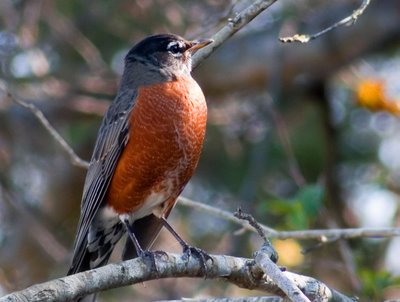
Another robin, a few feet away from the first. The robins are back in large numbers now.
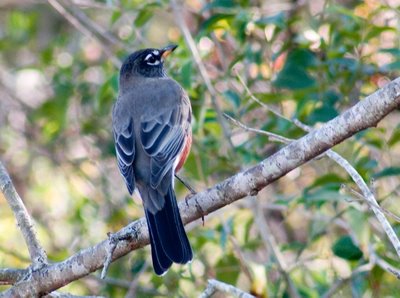
(Click any photo for a larger view.)
Note: No more posts here till after Thanksgiving.

We still have a few straggling flowers in Austin. We have not yet had a killing frost, but we will soon. This is some kind of small aster, blown up larger than life size.

A nightshade species.

A robin near Onion Creek.

Another robin, a few feet away from the first. The robins are back in large numbers now.

(Click any photo for a larger view.)
Note: No more posts here till after Thanksgiving.
Friday, November 17, 2006
More November butterflies, and a hermit thrush
A red admiral, Vanessa atalanta, in the afternoon sun at the Onion Creek greenbelt

A variegated fritillary, Euptoieta claudia, also in the greenbelt

Another view of the frit

This hermit thrush was left staring warily at me, occasionally flicking its wings, after the tree full of robins I had been stealthily approaching (I should put stealthily in quotes) exploded in alarm--actually, it was three separate salvos of robins, 15 or 20 each I guess, launched about half a second apart, rocketing through half-bare November hackberry branches as I fumbled with my camera. Damn, I thought, so much for stealth. But the hermit thrush was still there, nervous, wondering what I was doing down there, but unwilling to leave.

click any photo to enlarge

A variegated fritillary, Euptoieta claudia, also in the greenbelt

Another view of the frit

This hermit thrush was left staring warily at me, occasionally flicking its wings, after the tree full of robins I had been stealthily approaching (I should put stealthily in quotes) exploded in alarm--actually, it was three separate salvos of robins, 15 or 20 each I guess, launched about half a second apart, rocketing through half-bare November hackberry branches as I fumbled with my camera. Damn, I thought, so much for stealth. But the hermit thrush was still there, nervous, wondering what I was doing down there, but unwilling to leave.

click any photo to enlarge
Thursday, November 16, 2006
The new atheism
I've just been reading an article by Gary Wolf, in Wired News, which can be summarized as saying that the fatal flaw of atheism is that atheists are assholes. Or more strictly, he is saying--given the nuanced picture he paints of Richard Dawkins, Sam Harris, and Daniel Dennett--that they are, just slightly, insufferable. I thought of Alice B. Toklas dismissing Ezra Pound as a village explainer. She was using essentially the same argument.
Now, one can say that Wolf misses the point, and obviously, if the point is the truth of atheism, that would be correct. Defenders of Pound's poetry can consider the truth of Toklas's put-down irrelevant. But Wolf makes a good case that that line of reasoning is more worthy of consideration than we might initially think.
It occurred to me, in reading Wolf, that some of the more passionate contemporary atheists replicate the fervor of partisans in the war on terror in--for example-- advancing Bernard Lewis-like arguments against islam...and then go on, in the name of reason and consistency, to use the same arguments against Christianity. Take Harris, who is an atheist crypto-Buddhist, but who becomes evangelical in his crusade against Islam, using rhetoric Richard Perle himself might be comfortable with, although actually Perle might be a bit less inflammatory. The difference of course (to be fair, one of many differences) is that Harris goes on to discover the same flaws in Christianity and supernaturalism in general--namely, that, as belief-systems, they are all inimical to civilization, and should be eradicated. That means the ideas ought to be eradicated, not the people, but it is hard to eradicate ideas, especially given that the bearers of these ideas regard the ideas as proxies for their very selves, and will defend the ideas with the fervor of anyone defending the homeland (another proxy for the fortified self) against its enemies, to the death. That way lies trouble. I say that as another crypto-Buddhist.
So are notable militant atheists like Dawkins and take-no-prisoners bloggers like PZ Myers theological counterparts of neoconservatives? I'm guessing Dawkins and Myers are politically left, and hence would reject the proposition with vigor, if not horror...but...how about the crusader spirit, the scorn for weakness and negotiation? Well, you'll have to answer the question on your own.
Anthropologists have always taken religion to be rational, not in the way that philosophers speak of rationality, but kind like economists do when they are talking about the rationality of the market. The market operates rationally even though the stuff you buy cannot necessarily be philosophically justified. SUVs are bad for the world, but you get a sense of well-being, allegedly at least, in exchange for your money, and the market system (well, supposedly) rationally adjusts the disconnect between your needs and your pocketbook.
Perhaps the word rational is operating as a pun in this discourse--a play on the word, though the pun is not especially funny.
I do consider that militant Islam and evangelical Christianity are, in fact, a danger to civilization. But I don't want to be a danger to civilization myself.
Militant Islam is not the same as Islam. For a long time I was a subscriber--a silent member--of an online Sufi discussion list. Unlike the people on any other internet discussion group I have ever been part of, including Buddhist ones, the Sufis were polite, unflappable, and they damped out any incipient flame-wars with humor, generous good will, and cheerful invitations for one and all to find something holy both in the views of the flamer (who were very rare on the list to start with) and in the views that the would-be flamers were denouncing as vile and beyond the pale. And we all know that online exchanges are--normally--notorious for acrimony.
These Sufis seemed to me, after I had been reading their thoughts for a couple of years, to be the most balanced, the most urbane, the most generously thoughtful, and the least self-important group of people I have ever met online. In other words, they behaved like exemplary guests in your home would behave, but with strangers. You can't get more civilized than that.
These were traditional Chishtiyya Sufis, not Western new-age type Sufis--they were devout Muslims, from Muslim countries, and spoke English on the list only because it served as a common language. Of course, they were mystics, and thus might be considered heretics by puritanical Saudis, but they thought of themselves simply as ordinary Muslims. They just tended to have a reverential viewpoint on the world in general, and probably would define God--which they did not seem much interested in doing--as that which they were reverent about, in the world. A far cry from what atheists want to dislike.
I am certainly as guilty as anyone else of having a scornful view of evangelical Christians. As a Buddhist I try to remind myself, often and unsuccessfully I am afraid, that dissing someone's religion does no good.
Returning to my SUV bad example, suppose you are concerned about global warming and want to convince people to stop buying SUVs. How do you do that? I don't claim to know the secret, but surely it would not consist in hectoring them and pointing to them the harm that SUVs do. You can successfully point out SUV harmfulness to people who already don't have them, but not to those who do. Obviously, those folks think otherwise or they would not have bought the damn things. The harangue is not a good tool for this work.
postscript:
But [if someone who wants to stay on-message asks] do I believe in God? Like many Buddhists, I tend to think the question is unimportant. If pressed, though, I guess I would answer like a Chishtiyya Sufi.
Now, one can say that Wolf misses the point, and obviously, if the point is the truth of atheism, that would be correct. Defenders of Pound's poetry can consider the truth of Toklas's put-down irrelevant. But Wolf makes a good case that that line of reasoning is more worthy of consideration than we might initially think.
It occurred to me, in reading Wolf, that some of the more passionate contemporary atheists replicate the fervor of partisans in the war on terror in--for example-- advancing Bernard Lewis-like arguments against islam...and then go on, in the name of reason and consistency, to use the same arguments against Christianity. Take Harris, who is an atheist crypto-Buddhist, but who becomes evangelical in his crusade against Islam, using rhetoric Richard Perle himself might be comfortable with, although actually Perle might be a bit less inflammatory. The difference of course (to be fair, one of many differences) is that Harris goes on to discover the same flaws in Christianity and supernaturalism in general--namely, that, as belief-systems, they are all inimical to civilization, and should be eradicated. That means the ideas ought to be eradicated, not the people, but it is hard to eradicate ideas, especially given that the bearers of these ideas regard the ideas as proxies for their very selves, and will defend the ideas with the fervor of anyone defending the homeland (another proxy for the fortified self) against its enemies, to the death. That way lies trouble. I say that as another crypto-Buddhist.
So are notable militant atheists like Dawkins and take-no-prisoners bloggers like PZ Myers theological counterparts of neoconservatives? I'm guessing Dawkins and Myers are politically left, and hence would reject the proposition with vigor, if not horror...but...how about the crusader spirit, the scorn for weakness and negotiation? Well, you'll have to answer the question on your own.
Anthropologists have always taken religion to be rational, not in the way that philosophers speak of rationality, but kind like economists do when they are talking about the rationality of the market. The market operates rationally even though the stuff you buy cannot necessarily be philosophically justified. SUVs are bad for the world, but you get a sense of well-being, allegedly at least, in exchange for your money, and the market system (well, supposedly) rationally adjusts the disconnect between your needs and your pocketbook.
Perhaps the word rational is operating as a pun in this discourse--a play on the word, though the pun is not especially funny.
I do consider that militant Islam and evangelical Christianity are, in fact, a danger to civilization. But I don't want to be a danger to civilization myself.
Militant Islam is not the same as Islam. For a long time I was a subscriber--a silent member--of an online Sufi discussion list. Unlike the people on any other internet discussion group I have ever been part of, including Buddhist ones, the Sufis were polite, unflappable, and they damped out any incipient flame-wars with humor, generous good will, and cheerful invitations for one and all to find something holy both in the views of the flamer (who were very rare on the list to start with) and in the views that the would-be flamers were denouncing as vile and beyond the pale. And we all know that online exchanges are--normally--notorious for acrimony.
These Sufis seemed to me, after I had been reading their thoughts for a couple of years, to be the most balanced, the most urbane, the most generously thoughtful, and the least self-important group of people I have ever met online. In other words, they behaved like exemplary guests in your home would behave, but with strangers. You can't get more civilized than that.
These were traditional Chishtiyya Sufis, not Western new-age type Sufis--they were devout Muslims, from Muslim countries, and spoke English on the list only because it served as a common language. Of course, they were mystics, and thus might be considered heretics by puritanical Saudis, but they thought of themselves simply as ordinary Muslims. They just tended to have a reverential viewpoint on the world in general, and probably would define God--which they did not seem much interested in doing--as that which they were reverent about, in the world. A far cry from what atheists want to dislike.
I am certainly as guilty as anyone else of having a scornful view of evangelical Christians. As a Buddhist I try to remind myself, often and unsuccessfully I am afraid, that dissing someone's religion does no good.
Returning to my SUV bad example, suppose you are concerned about global warming and want to convince people to stop buying SUVs. How do you do that? I don't claim to know the secret, but surely it would not consist in hectoring them and pointing to them the harm that SUVs do. You can successfully point out SUV harmfulness to people who already don't have them, but not to those who do. Obviously, those folks think otherwise or they would not have bought the damn things. The harangue is not a good tool for this work.
postscript:
But [if someone who wants to stay on-message asks] do I believe in God? Like many Buddhists, I tend to think the question is unimportant. If pressed, though, I guess I would answer like a Chishtiyya Sufi.
Wednesday, November 15, 2006
More bug and bird photos
I have been more inclined to read than to write, lately, and I am at the moment occupied reading George Monbiot's Heat: How to stop the planet from burning. I am not yet sure whether it is a hopeful book or a depressing one--he proposes, at the beginning, that the 80% carbon emissions reduction estimated by many climate scientists to be needed to avoid catastrophic global warming is wrong, and that a 90% reduction is actually required. Then he says he thinks it can be done. Given that the less-than-10% goal of Kyoto has not been met, if for no other reason than having been effectively sabotaged by the United States, his claim that a 90% reduction can be reached has caught my interest--but I am closer to the beginning of the book than the end.
One thing he says at the outset--and I am sure he is right about it--is that sporadic individual action, however well intended, won't suffice, and that persuading governments in the developed world to take action is the key.
But more of this later, perhaps, after I finish the book. For now, here are some Tuesday pictures of Town Lake wildlife.
This is a female American rubyspot, Hetaerina americana
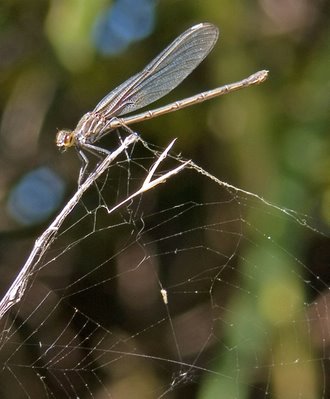
Another female rubyspot

...and a male American rubyspot

A snowy egret.
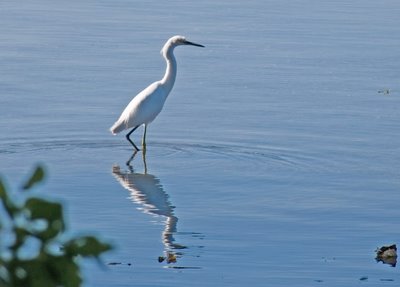
click any image to enlarge
One thing he says at the outset--and I am sure he is right about it--is that sporadic individual action, however well intended, won't suffice, and that persuading governments in the developed world to take action is the key.
But more of this later, perhaps, after I finish the book. For now, here are some Tuesday pictures of Town Lake wildlife.
This is a female American rubyspot, Hetaerina americana

Another female rubyspot

...and a male American rubyspot

A snowy egret.

click any image to enlarge
Saturday, November 11, 2006
Saturday random juxtapositions
Onion Creek Baldcypress trees. This is at the upper McKinney Falls. Some years the cypress trees provide a bit of fall color.
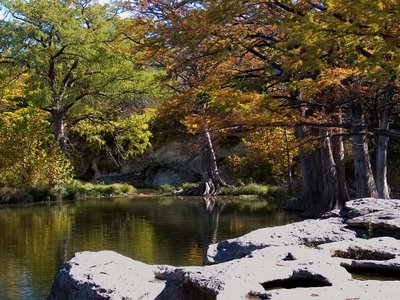
A ruby-crowned kinglet also near Onion Creek
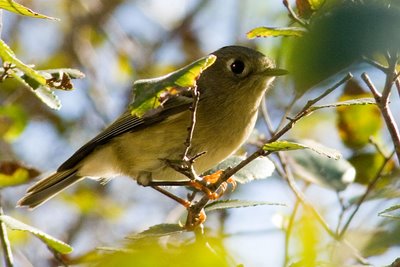
Roseate skimmer, Orthemis ferruginea. These are very handsome dragonflies. I took the photo several days ago, in Zilker Park.
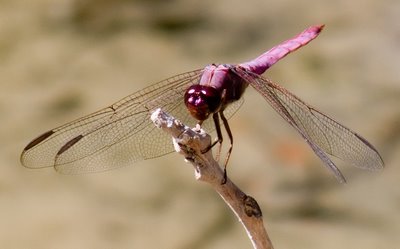
Yet another American snout butterfly, Libytheana carinenta. They are amazingly abundant around Austin this fall. No one knows why, really. This one has obligingly, and uncharacteristically, opened its wings. Generally they keep their wings folded and look like dead gray leaves.
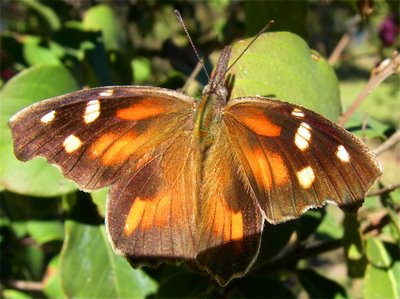
Click any photo to enlarge

A ruby-crowned kinglet also near Onion Creek

Roseate skimmer, Orthemis ferruginea. These are very handsome dragonflies. I took the photo several days ago, in Zilker Park.

Yet another American snout butterfly, Libytheana carinenta. They are amazingly abundant around Austin this fall. No one knows why, really. This one has obligingly, and uncharacteristically, opened its wings. Generally they keep their wings folded and look like dead gray leaves.

Click any photo to enlarge
Thursday, November 09, 2006
November butterflies
We have not yet had a freeze in Austin, and we have some fall flowers after the recent rains. So we still have lots of butterflies. The most common are American snouts, which which I have uploaded photos of before. Here are some other species.
A gulf fritillary, Agraulis vanillae
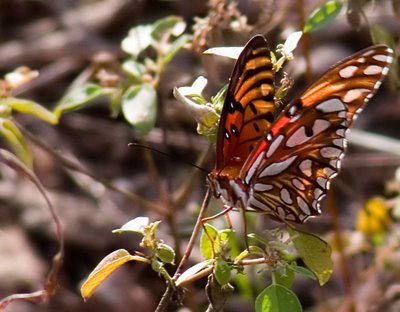
Another view of the same butterfly

This is a theona checkerspot, Chlosyne theona
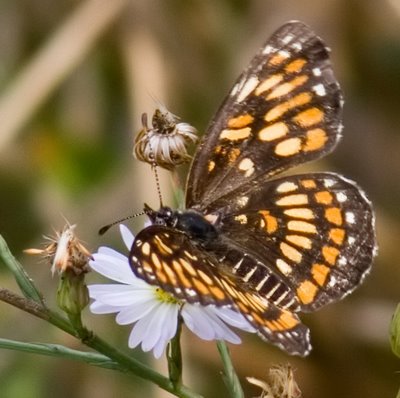
A phaon crescent, Phyciodes phaon
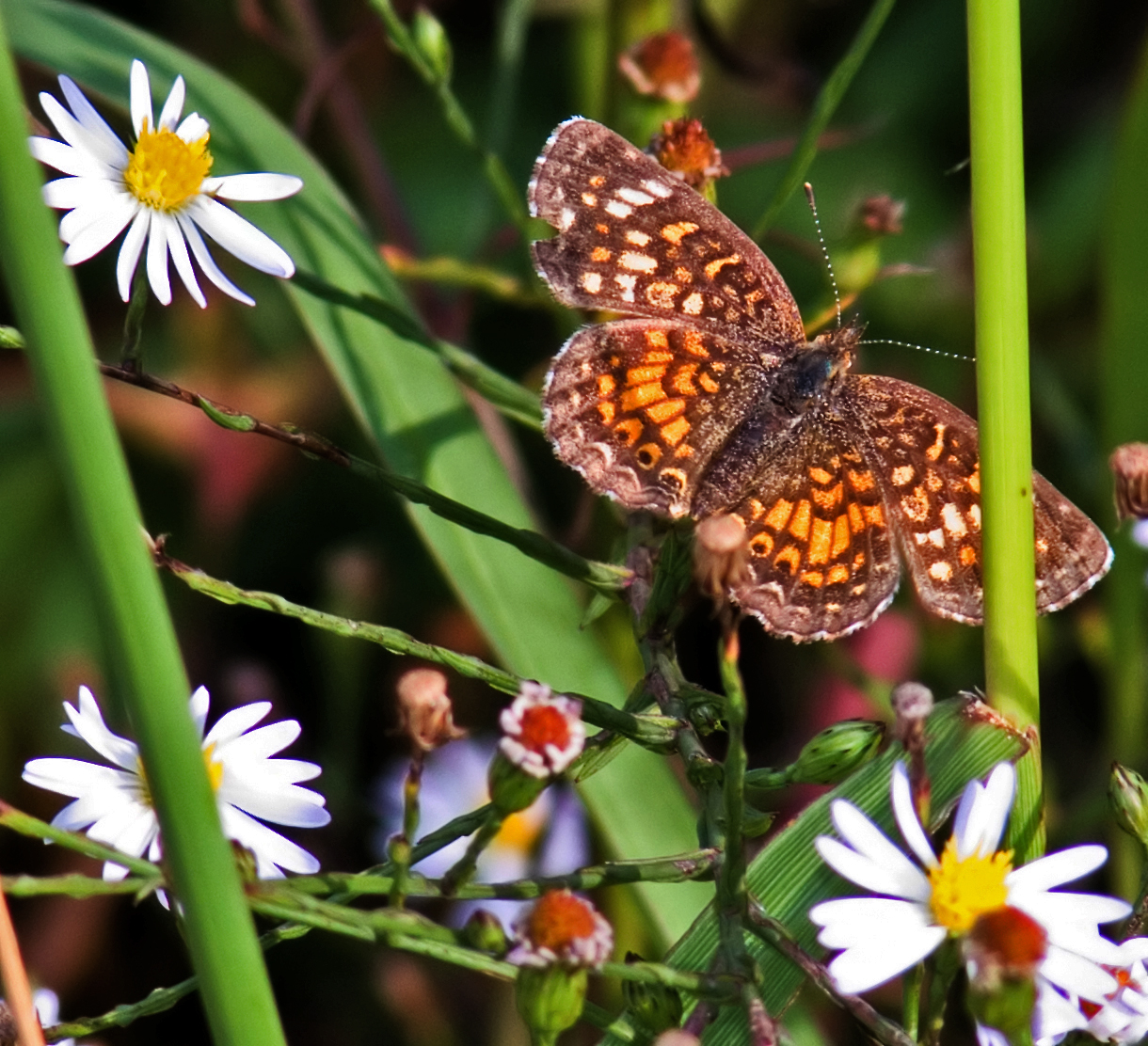
Both the phaon and the checkerspot are flitting around in some small white aster flowers.
(click any image to enlarge)
A gulf fritillary, Agraulis vanillae

Another view of the same butterfly

This is a theona checkerspot, Chlosyne theona

A phaon crescent, Phyciodes phaon

Both the phaon and the checkerspot are flitting around in some small white aster flowers.
(click any image to enlarge)
Wednesday, November 08, 2006
A fine day for a walk
In November of 1960 I was 19 and a university sophomore and I had paid my Texas poll tax and I voted for the first time, and I voted for John Kennedy. The election was a real cliff-hanger. Sometime after midnight, when it seemed reasonably likely that Kennedy had actually won, I went with a friend of mine to a cafe in downtown Austin that was open all night and was a hangout for local politicos. Everyone was in a celebratory mood, and at maybe two in the morning Lyndon Johnson, the new Vice President of the US, walked in and began shaking everyone's hand. He shook mine. I was real happy.
Of course, four years later I was picketing Lyndon Johnson's ranch.
I don't recall a moment of unalloyed pleasure at the results of an American election since that night in 1960. The first couple of years of the Kennedy administration set a high bar, I suppose.
But this morning, once again, I feel happy about an election, probably because George Bush has set a new sort of benchmark--I can't call it a high bar--as the worst president in American history. And I think the election showed the public is coming to realize it. I'm not fooling myself that control of the House and a possible razor-thin control of the Senate will make a huge difference in the direction Bush is going, but it will certainly slow him down.
Texas, naturally, did not join in the nationwide waking-up event, but there were signs of consciousness even here. A Democrat won Tom Delay's old congressional seat. I think that's called sending a message.
And it's a clear, sunny day here in Austin, and I don't feel like sitting in front of a keyboard much longer, so I'm outa here. Later.
Of course, four years later I was picketing Lyndon Johnson's ranch.
I don't recall a moment of unalloyed pleasure at the results of an American election since that night in 1960. The first couple of years of the Kennedy administration set a high bar, I suppose.
But this morning, once again, I feel happy about an election, probably because George Bush has set a new sort of benchmark--I can't call it a high bar--as the worst president in American history. And I think the election showed the public is coming to realize it. I'm not fooling myself that control of the House and a possible razor-thin control of the Senate will make a huge difference in the direction Bush is going, but it will certainly slow him down.
Texas, naturally, did not join in the nationwide waking-up event, but there were signs of consciousness even here. A Democrat won Tom Delay's old congressional seat. I think that's called sending a message.
And it's a clear, sunny day here in Austin, and I don't feel like sitting in front of a keyboard much longer, so I'm outa here. Later.
Monday, November 06, 2006
Monday at Zilker Park
Here is a miscellany of photos I took in Zilker today, first below Barton Springs, and then in Zilker Gardens.
These gadwalls and the snowy egret were sharing a rock in the middle of Barton Creek below the dam.
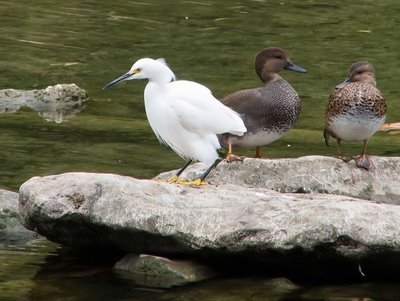
Another pair of gadwalls resting on a flat rock by the bank.

Fox squirrel by the creek
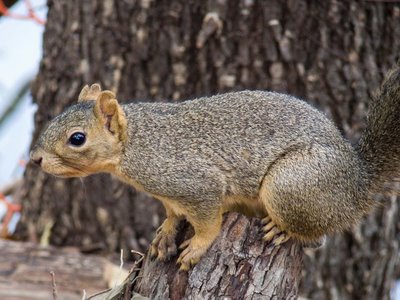
Here are two desert firetails (Telebasis salva) on a lily pad in Zilker Gardens. They have just mated, and the female is now in the process of laying eggs. The male is still attached to her head. Odonate sex, like all sex, looks strange. The male attaches behind the female's head, then the female reaches up with the end of her abdomen to fertilize her eggs at the male genitalia. Then she can lay the eggs, which is what's going on here. With some odonates, like these desert firetails, the male remains attached to the female's head while the egg-laying is going on. I am not sure why.

This is another great spreadwing, Archilestes grandis. Zilker Gardens is the only place I seem to find them.

Click any photo to enlarge
These gadwalls and the snowy egret were sharing a rock in the middle of Barton Creek below the dam.

Another pair of gadwalls resting on a flat rock by the bank.

Fox squirrel by the creek

Here are two desert firetails (Telebasis salva) on a lily pad in Zilker Gardens. They have just mated, and the female is now in the process of laying eggs. The male is still attached to her head. Odonate sex, like all sex, looks strange. The male attaches behind the female's head, then the female reaches up with the end of her abdomen to fertilize her eggs at the male genitalia. Then she can lay the eggs, which is what's going on here. With some odonates, like these desert firetails, the male remains attached to the female's head while the egg-laying is going on. I am not sure why.

This is another great spreadwing, Archilestes grandis. Zilker Gardens is the only place I seem to find them.

Click any photo to enlarge
Friday, November 03, 2006
Poorly matched photos
It seems odd to put these two photos up in the same post. What they have in common is that I saw both these guys on my walk today along Onion Creek, and that they both let me get very close. The reason I got close to the mestra was that it was cold and hence inactive. I don't know why I was able to approach so close to the vulture. Sometimes they are reluctant to abandon their meal, but this one was not feeding on anything.
Common mestra, Mestra amymone. I mentioned in another post that blogger somehow muted the colors of a previous photo of this same species of butterfly. This one looks a little better.
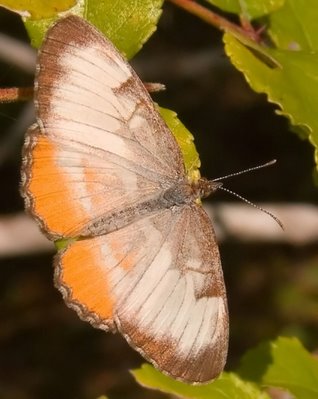
Black vulture. Vultures are more closely related to storks than to birds of prey. You can kind of see that here.
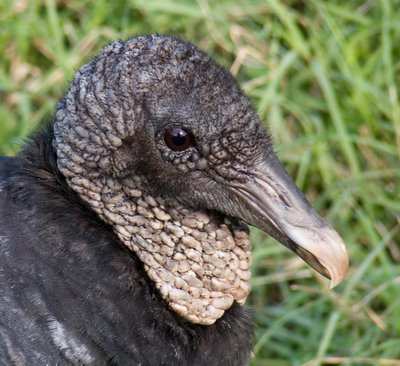
click photos to enlarge
Common mestra, Mestra amymone. I mentioned in another post that blogger somehow muted the colors of a previous photo of this same species of butterfly. This one looks a little better.

Black vulture. Vultures are more closely related to storks than to birds of prey. You can kind of see that here.

click photos to enlarge
Subscribe to:
Comments (Atom)

